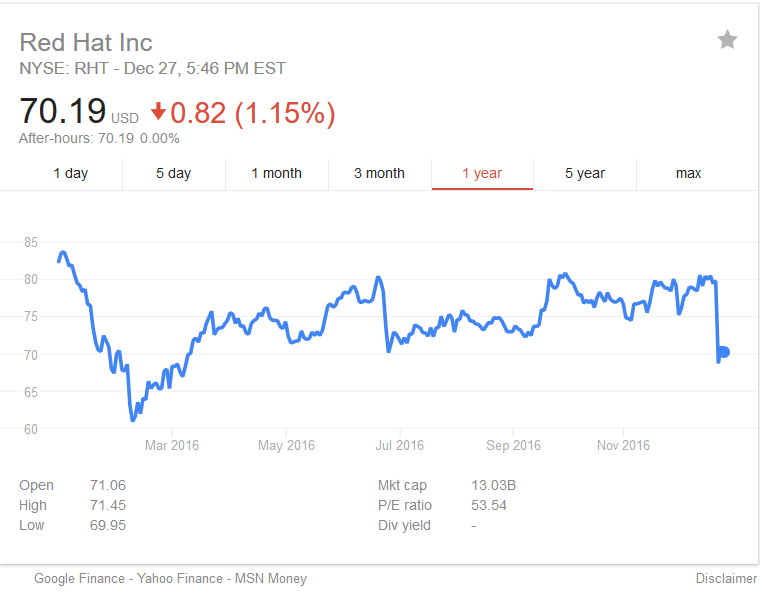Source: Red Hat

Last week Red Hat, Inc. (NYSE: RHT), a leading provider of open source and enterprise IT solutions, reported its third quarter results for the fiscal year 2017 ended November 30, 2016, posting total Q3 revenue of $615 million, an 18 percent increase and total subscription revenue of $543 million, a 19 percent increase year-over-year. Subscription revenue represents 88.3 percent of Red Hat revenue.
Other highlights for Q3 FY 2017 include:
- Subscription revenue is broken out into two categories. Infrastructure related services revenue was $431 million for Q3, a 16 percent increase year-over-year. Application development-related and other emergency technology revenue was $112 million, a 33 percent increase year-over-year.
- GAAP operating income for Q3 was $81 million, a 17 percent increase year-over-year.
- GAAP net income for Q3 was $68 million, or $0.37 per diluted share, compared to $47 million, or $0.25 per diluted share, for the same period last year.
“Enterprise and service provider customers continue to adopt a hybrid cloud strategy for developing, deploying and managing the life-cycle of their critical applications. Red Hat is uniquely positioned to address this need. In aggregate, customers utilizing our cloud-enabling technologies either on-premise or in the public cloud are spending more with Red Hat than customers that have not yet embraced our cloud-enabling technologies,” said Jim Whitehurst, President and CEO, in the December 21 earnings announcement.
Source: Red Hat

For the fourth quarter, Red Hat estimates revenue will be between $614 million and $622 million. GAAP operating margin will be approximately 14 percent, and fully diluted GAAP earnings per share will be approximately $0.33 per share.
For the full year, Red Hat estimates revenue will range between $2.397 billion and $2.405 billion. GAAP operating margin will be approximately 13.5 percent, and fully diluted GAAP earnings per share will be approximately $1.33 per share.
What’s next? Red Hat is losing Frank Calderoni as its executive vice president of operations and chief financial officer of Red Hat. He’ll step down in late January to accept a CEO position at another company. The company will appoint Eric Shandler, vice president of finance and accounting and principal accounting officer as interim CFO.
Headquartered in Raleigh, North Carolina, Red Hat was founded in 1993. It employs 7,900 and has more than 80 offices in over 35 countries. Red Hat services companies including Adobe, Casio, E*Trade, Intuit, FICO and Sprint, and it partners with companies like Fujitsu, IBM, Intel, Symantec, Dell and Cisco.
Following the release of its earnings report, Red Hat stock dropped from $79.79 per share to $68.71 per share. The Street says that Red Hat’s Q3 earnings fell short of Wall Street revenue estimates of $618.5 million. News of the CEO stepping down likely contributed to the stock falling. Analysts including John DiFucci of Jeffries and Heather Bellini of Goldman Sachs both commented that federal deals which were supposed to close in Q3 but didn’t may also be contributing factors. Stock closed yesterday at $70.19 per share, compared to $82.34 on December 28, 2015.
Source: Google Finance – Yahoo Finance – MSN Money

Insider Take:
Red Hat’s third quarter earnings report was mostly positive, but missing Wall Street projections, not closing government deals as planned and losing its CEO hurt the company. To rebound from its current position, Red Hat needs to close its fourth quarter on or above target. While it may be able to close the government contracts in the fourth quarter, the company doesn’t have any control over Wall Street’s projections, and it is unlikely to have replaced its CEO by the end of its fiscal year 2017 in February.








